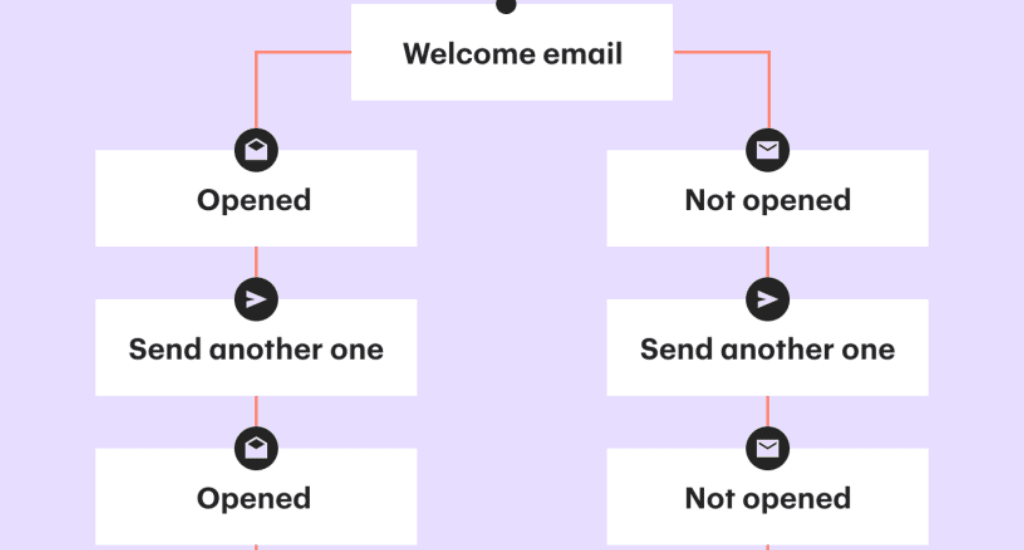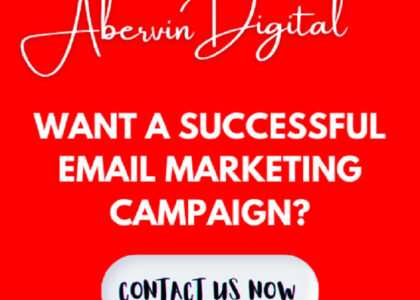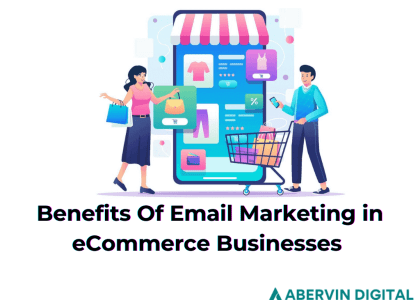So you want to master Email Drip Campaigns in 2025 and finally start seeing consistent, meaningful results from your email list?
Smart move.
People are obsessed with viral Reels, AI chatbots, and algorithm-chasing on social media but the brands that truly get it are circling back to something way more strategic: email drip campaigns
While most brands scramble and chase a quick sale, these smart brands know that sending automated, behavior-based, value-first emails builds trust, gets your subscribers to take action, and leads to consistent results on autopilot. That’s the power of email drip campaigns.
And if you’re here, you’re clearly not about random blasts and praying for clicks. You’re here to set up systems that work for you even while you sleep. You’re ready to join the smart brands leaving the one-size-fits-all emails behind. No more “Flash sale!” and “New drop!” spam. You’re building emails that actually convert.
That’s what this playbook is all about. Let’s get into it.
What are Email Drip Campaigns?

An email drip campaign is a sequence of automated emails sent over time based on a user’s behavior or a set schedule. Think of it like a Netflix series where each episode builds on the last to pull you deeper into the story. Same thing here, except you’re guiding leads through your sales journey instead of plot twists.
Let’s say someone downloads your free ebook. Instead of dropping the PDF and ghosting them, you build a drip:
- Day 1: Thank you email
- Day 3: A quick insight from the ebook
- Day 6: A related product they’d love
Each message flows into the next. Purposeful. Timed. Strategic. That’s the essence of a drip.
Unlike one-off newsletters or blasts, email drip campaigns are smart, personalized, and triggered by specific actions or milestones. This makes them feel like a conversation not a sales pitch.
Key Drip Campaign Terms You Should Know
Drip campaigns also lean heavily on automation – but before we get there, let’s break down a few terms you’ll see often:
- Trigger: This is the action or event that sets the drip campaign in motion. For example, if someone signs up for a webinar, or someone abandoning their cart, or clicking a link in a previous email this will “trigger” the drip campaign so they receive your emails.
- Condition: These are the rules that decide who gets sent the messages in your drip or what happens next (sometimes, what happens is that they don’t get a message, they get unsubscribed or put in a list). Maybe you only want people who opened the first email to get the second one. That’s also a condition.
- Timing (or Delay): This controls when emails go out. So you can set up a drip to messages out over hours, days, or weeks depending on your goal and customer behavior.
While building drip campaigns is key, none of it matters if the person setting it up doesn’t know what they’re doing. Before you trust someone with your list, make sure you know how to hire email marketing experts the right way and not just someone who can “send emails,” but someone who gets real results.
The Best Email Drip Campaigns (That Actually Work)
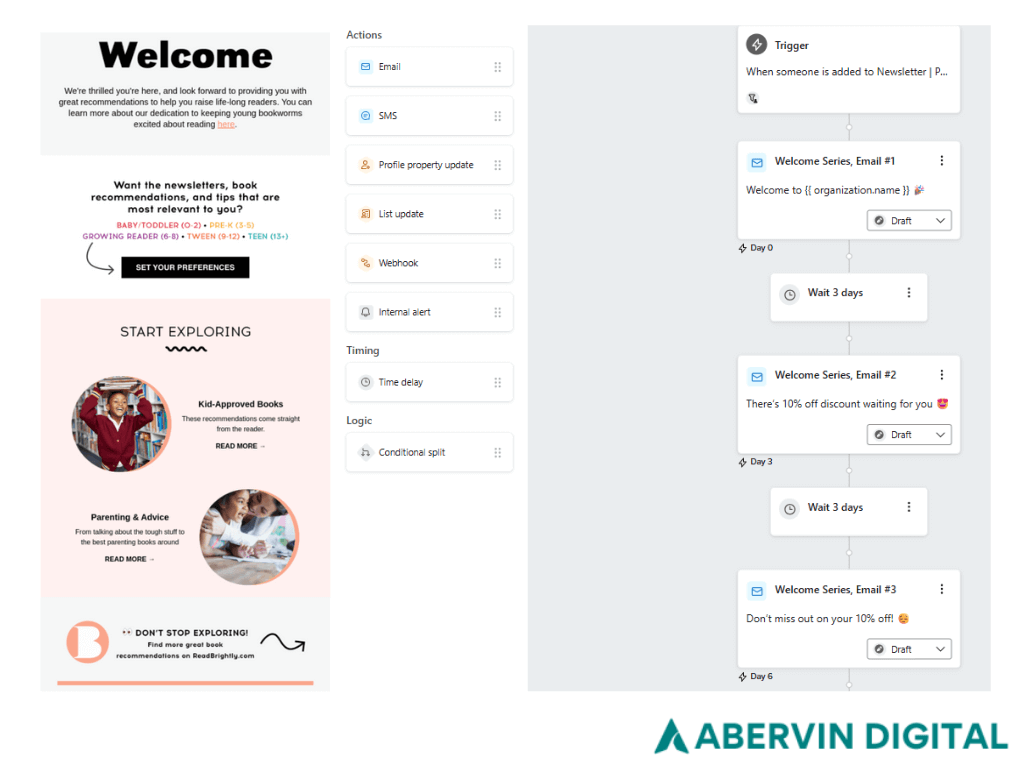
There are tons of ways to use email drip campaigns across your customer journey. But no matter your niche, a few types stand out because they consistently deliver real results.
Here are some of the best email drip campaigns to model:
Welcome Drips:
The welcome sequence is your first real “hello” to anyone who joins your list. Whether someone signs up via a free download, a product trial, or a first-time purchase, this is your golden window for building trust.
The best email drip campaigns in this category go beyond a “thanks for subscribing.” They introduce your brand’s voice, clarify what to expect, and guide your subscriber to that “aha!” moment.
For example, an e-commerce brand might send:
Email 1: “Welcome to the community!” (with a discount code)
Email 2: “How we make our products sustainably” (values-driven storytelling)
Email 3: “Our most-loved items this month” (social proof and discovery)
Welcome drips help you onboard subscribers smoothly and start the relationship with relevant content that provides value. In many cases, this is your highest open-rate window because it’s the time when most subscribers expect to see an email from you – so don’t waste it with generic messaging.
Nurture Drips:
These campaigns target prospects who have shown interest but aren’t ready to buy. They’ve downloaded a whitepaper, clicked on a blog post, or watched a webinar but they’re still gathering information. Which is why a well-timed email drip campaign keeps the convo going.
Your goal here is to educate them about your brand, product and services and build trust. You’re gently guiding them through the buyer’s journey with relevant content that answers their questions, addresses objections, and frames your brand as the solution.
A B2B software company, for instance, might set up a drip like this:
Email 1: “5 signs it’s time to upgrade your project management tool”
Email 2: “Case study: How [Company] improved team collaboration by 40%”
Email 3: “Feature comparison: Us vs. the competition”
Email 4: “Ready to see it in action?” (Call To Action to book a demo)
So the idea here is not to rush or push the sale prematurely, it’s about sending messages that keep you top-of-mind for the lead while they learn about your value.
Abandoned Cart Drips:
Shopping cart abandonment is one of the most costly friction points in e-commerce, with industry averages hovering around 70%. Email drip campaigns for abandoned carts are designed to recover lost revenue by reminding users of what they left behind – and more importantly, why they wanted it in the first place.
These drips work best when personalized with product images, dynamic pricing, or scarcity cues like low stock alerts. All of which can be set up in some of the best email marketing platforms. This guide on essential email marketing platform features breaks down what to look for, so your email marketing platform don’t hold back your strategy.
Timing matters a lot here – if your drip goes out too slow,, the customer cools off and if you blast off too fast it feels pushy. When in doubt, use our sample timing above. The best cart recovery sequences creates a sense of urgency in the recipient – it looks something like:
Email 1 (1 hour later): “Still thinking it over? Your items are waiting.”
Email 2 (24 hours later): “Here’s what others are saying about [Product]” (include reviews in email)
Email 3 (48–72 hours later): “Take 10% off before your cart expires” (create a deadline)
Re-engagement Drips:
Even your most loyal subscribers can go cold. Maybe they changed jobs. Maybe they’re just busy. Whatever the reason, re-engagement email drip campaigns give you one last shot to revive the relationship.
Think of these like the friendly “hey, still there?” nudge. Here’s how they should flowy:
Acknowledge the inactivity without guilt (“We’ve missed you!”)
Offer a new reason to engage (updated features, exclusive content, or a special promo)
Ask for feedback (“What can we do better?”)
Provide an easy opt-out or pause option
If subscribers ignore the entire re-engagement sequence, it may be time to clean your list. This improves deliverability metrics and ensures your emails are reaching people who actually want them.
In 2025, attention is currency. People are bombarded with content, and their time is more fragmented than ever. What used to work – generic emails sent at random – just doesn’t cut it anymore which is why drip campaigns are essential to help you cut through the noise. And they work because they’re personal and timely.
Best Tools to Run Your Email Drip Campaigns
You don’t need to be a tech wizard to run the best email drip campaigns…you just need the right tools. Here are some favorites by type::
- Klaviyo: Great for e-commerce. It syncs with Shopify and tracks customer behavior for deeply personalized drips.
- Mailchimp: Easy for beginners. Offers pre-built automation journeys and drag-and-drop setup.
- ActiveCampaign: Powerful logic-based automation and CRM tools for advanced drip strategies.
- ConvertKit: Best choice for creators and bloggers. Clean automation flow and tag-based system.
- HubSpot: Ideal for B2B and SaaS. Combines email, CRM, and workflows in one platform.
- Drip: E-commerce focused with simple automation and visual workflows.
- MailerLite: Budget-friendly with strong automation tools for small businesses.
Planning Your Email Drip Campaigns: From Goal to Execution
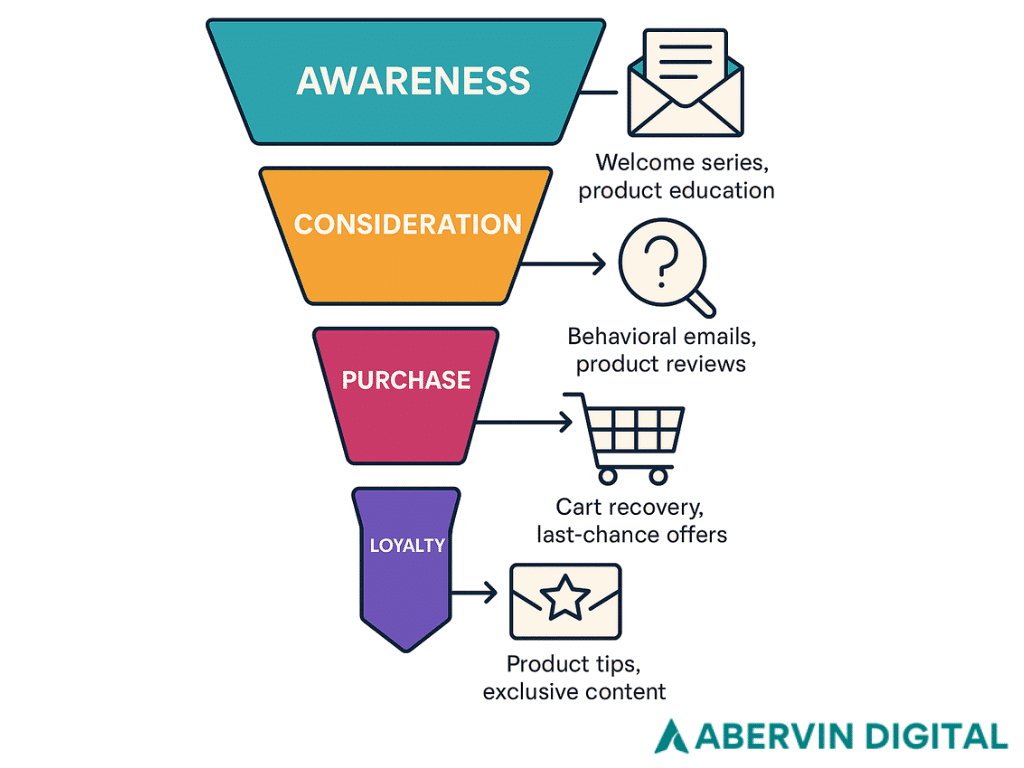
If you’re diving into email drip campaigns for the first time, pause before you start queuing up emails. A winning email drip campaign isn’t about sending a bunch of automated messages…it’s about strategy.
This starts with having a clear goal, understanding your audience, and delivering the right message at the right time. So before you even think about writing a subject line or dropping images into a template, take a step back and ask:
What’s the one result I want from this email drip campaign?
One Goal, Many Emails – But One Message
It might seem tempting to address multiple objectives at once – upselling, educating, getting referrals, and re-engaging lapsed users – all in one sequence.
But the best email drip campaigns keep it simple and focused. Each email should move the reader one step closer to the same goal.
Let’s say your goal is to get demo bookings for your SaaS product. Your drip sequence could look something like this:
- Email 1: “See how [customer name] cut their project time by 30%” (case study-based trust builder)
- Email 2: “5 hidden costs of not having a workflow tool” (pain-point amplifier)
- Email 3: “Book a 15-min walkthrough for your team” (direct CTA)
There may be a few emails but there is only one goal and each email builds on the previous one, reinforcing the same idea from a different angle. Trying to do too much in one series dilutes the impact but having a singular goal helps you define success metrics and clarifies your messaging.
Now that you have a goal, the next step is figuring out who you’re talking to and where they are in their decision-making process.
Identify Your Audience and Their Buyer Journey Stage
Identifying your audience is not just about demographics – age, job title, or industry.
If you’re running email drip campaigns in 2025, knowing your audience is knowing their intent, behavior, and the right timing for sending particular messaging. Most leads don’t show up ready to buy. They’re scattered across awareness, consideration, or post-purchase stages. Knowing this lets you deliver email drip campaigns that actually feel human and helpful because they are.. Your leads are usually in one of these stages:
Awareness Stage aka Problem Discovery:
Your lead is just waking up to the fact that… something’s off.
Maybe they’re feeling a pain point, but they haven’t named it yet. They’re not shopping… they’re searching. Think blog posts, checklists, free guides or anything that makes them say, “Oh wow, this explains what I’m going through.”
They’re downloading a “Beginner’s Guide,” grabbing a checklist, or subscribing to your newsletter without taking further action. That’s a red flag (in a good way) that they’re in the awareness stage.
This is where your email drip campaigns should be all about education and empathy. No hard sells… just clear, relatable content that builds trust and positions your brand as the guide.
Consideration/Decision Stage:
Now they know they’ve got a problem and they’re exploring how to solve it. Your lead is clicking around your site, revisiting your product pages, reading case studies, and maybe even peeking at your pricing.
At this point, they don’t just want information. They want clarity and confidence.
- This is the time to hit them with those meaty emails:
- Feature breakdowns
- Comparison charts
- Real-life success stories from people like them
Show them why your offer is the obvious choice. This is where the best email drip campaigns shine because they’re designed to overcome hesitation and drive momentum.
And yes, your CTA matters more than ever here. Invite them to take that next step: book a demo, start a free trial, or talk to a human.
Loyalty Stage: Post-Purchase Engagement:
People here have made a purchase or signed a contract but the journey doesn’t stop after the first conversion. In fact, your most profitable audience may be the customers you’ve already earned. The smartest email drip campaigns continue after the sale … whether it’s getting them to make repeat purchases, upgrades, or simply keeping your brand top-of-mind, retention-focused drips like emails with personalized product recommendations, exclusive discounts, Invitations to webinars, referral programs, or loyalty events can help these customers feel supported, seen, and continually rewarded for choosing you.
Matching your drip content to the prospects mindset at every stage is how you meet people exactly where they are and guide them one step forward. This is what turns passive readers into active customers.
Write Subject Lines That Get Opened

Here’s the cold truth: your email could be fire… but if the subject line flops, it’s going straight to archive (or worse, spam).
Most people scan their inbox passively. They’re looking for reasons to delete, not engage. So your subject line has to break through that mental filter with one of two strategies: curiosity or clarity.
The most effective subject lines however, blend the two. You provide enough detail to create relevance but leave enough tension to get your reader interested. An example is “Before You Hire Again, Read This”.
Now, emojis can make your subject lines pop but only if they match your audience and your tone. A B2B software company using the wrong emoji can feel off-brand or unprofessional, so we recommend using emojis to reinforce context, not replace words – and never use them in place of clarity. For a deeper dive into the dos and don’ts, check out our guide on how to use emojis effectively in email subject lines. For example:
- Risky Emoji Use: “🔥🚨 Don’t Miss This!” (What is “this”?)
- Good Emoji Use: “Summer Sale ☀️ 40% Off Just for You”
The rule of thumb: if your audience wouldn’t expect to see emojis in a LinkedIn message or business pitch, don’t put them in your subject lines. That said, avoid placing your only CTA at the base of a lengthy email. Be sure to include at least one CTA above the fold, and if your email is long, repeat it once more toward the end.
When you’ve gotten them to open the email… the challenge is holding your reader’s attention long enough to get them to take action. Let’s talk about designing emails for maximum readability.
Designing Emails for Maximum Readability
If you’re running email drip campaigns, every email must be easy to scan, swipe, and tap through. What works on a laptop might frustrate mobile users.
With over 60% of emails being read on mobile devices, your layout needs to prioritize thumb-friendly navigation and allow for readers to quickly scan the entire design. What works on desktop may not work as well for users on smaller screens.
So here are some tips we recommend you follow when designing your emails.
1. Stick to Single-Column Layouts
Multi-column formats may look sleek on a laptop, but they usually break on mobile. A single-column layout stacks content neatly, making it easier to scroll, read, and act without pinching or zooming.
2. Use Generous Spacing and Padding
White space guides the reader’s eye and gives each element room to breathe. So when designing, consider spacing out headers, paragraphs, and buttons with consistent padding (around 20–30px) to avoid a cluttered experience.
3. Prioritize the CTA’s Thumb Zone
CTA buttons get people to take action in your email drip campaigns, so they need to be mobile-friendly. Follow these tips:
- High contrast (e.g., orange on white).
- Clear text like “Download My Free Guide” > “Click Here.”
- Minimum size: 44×44 pixels.
- Positioned far from other tappable elements.
- Placed where natural scrolling pauses.
Make those thumbs happy and your conversions will follow.
4. Keep Key Info “Above the Fold”
On mobile, the “fold” is roughly the first 300–400 pixels. Use this space for your headline, a clear benefit, and your first CTA. Readers should instantly understand what the email is about and why they should care – without scrolling.
Preview your email on both mobile and desktop before sending. Tools like Litmus, Email on Acid, or even your ESP’s preview feature can show how your design performs across devices and inboxes. This final step can catch issues like broken buttons, overlapping text, or slow-loading visuals that could derail performance.
If your platform doesn’t offer this kind of previewing or automation, it might be time to compare tools. Here’s our breakdown of the essential email marketing platform features to look for in 2025.
Launching Your Email Drip Campaigns the Right Way
Sending emails is easy. Launching email drip campaigns that actually deliver results? Whole different story.
After you’ve spent time writing your copy, designing layouts, and setting up your automation, don’t just hit “send”. How you launch your campaign matters just as much as what you send. Without testing your email, you’ll never know if you have broken links which lead to low engagement, or worse – spam flags.
Pre-Send Checklist
So before launching, run through this pre-send checklist to ensure everything works as intended and looks professional:
Check All Links:
Every link and button should work, so click through each one to confirm it leads to the right destination. Check to be sure you don’t have any mistyped URLs or broken redirects because these are more common than we think – and they’re costly.
Verify Sender Name and Email:
No one wants an email from “[email protected].” If your sender name sounds cold or robotic, it’s a straight trip to the trash. Use a recognizable name and domain. Avoid generic “no-reply” addresses, which reduce trust and increase spam likelihood. Instead, go with “[Your Name] from [Brand]” or a branded team email.
Send Test Emails:
This is not optional. Send a preview to yourself, your intern, your cousin – whatever. Just see how it looks on real devices (Send test emails to various inboxes (Gmail, Outlook, Yahoo) and devices (mobile and desktop). Look for layout issues, spacing problems, or clipped messages. You can even BCC your colleagues. Don’t assume it looks good everywhere just because it looks good in Mailchimp preview.
Preview Your Merge Fields:
Adding “Hi {{ first_name }}” is not personalization – especially if it pulls blank or shows up broken. Personalization only works if it’s accurate so always preview how [First Name] or other dynamic fields populate and use fallback tags. A “Hey [First Name]” email that doesn’t populate is a fast path to unsubscribes.
Once you’ve confirmed that you’re good on everything on the checklist above, it’s time to consider a soft launch. What this means is instead of sending your campaign to your entire list at once, you send the first batch to a small, representative segment of your list – maybe 5-10%. This way you can monitor your email performance and fix any issues before scaling up. Once the test segment performs well, then you can full blast to your entire list confidently.
Soft launches are especially useful if you’re trying a new subject line strategy, testing a new audience segment, or launching to a cold list. But even the most carefully planned launch can fall flat if your emails never make it to the inbox.
That’s why your next priority should be making sure your emails get delivered – and stay out of the spam folder.
Avoiding Spam Traps and Deliverability Issues

Even the best email drip campaigns fail if they land in spam.
Deliverability is a foundational part of email success, and it’s more than just avoiding the “spam” folder. It’s about building a reputation with mailbox providers (like Gmail, Outlook, Yahoo) that you’re a trusted sender.
Here’s a deep dive into how to stay out of trouble and get your emails where they belong: in front of your audience:
Warm Up New Domains:
If you’re sending from a brand-new domain or subdomain, you need to “warm it up.” Inbox providers have built-in filters to catch mass senders who haven’t earned trust. Sending to your full list from day one is a fast track to getting throttled—or blocked entirely. Start small (e.g., 50–100 emails per day), gradually increasing volume over 2–4 weeks. Send to your most engaged subscribers first – those who are likely to open, click, or reply. Use a dedicated sending domain or subdomain (like mail.yourbrand.com) for email campaigns to isolate your marketing reputation from your root domain (especially helpful if you run e-commerce or other public-facing systems).
Clean Your List Regularly:
Your list quality is directly tied to your inbox placement. That means sending only to people who have opted in – and keeping that list updated. Remove inactive addresses, role-based emails (like info@ or support@), and anyone who hasn’t engaged in the last 6–12 months. Remove hard bounces immediately (these are invalid or non-existent addresses) because fewer bounces mean better placement. Avoid scraping or buying email lists. They often contain spam traps – emails created solely to catch bad actors.
Authenticate Your Email (SPF, DKIM, and DMARC):
Think of email authentication as your passport to the inbox. Without it, mailbox providers may assume your messages are spoofed or malicious – even if your intentions are good.
- SPF (Sender Policy Framework) tells ISPs which IP addresses are allowed to send mail on behalf of your domain.
- DKIM (DomainKeys Identified Mail) adds a digital signature to your messages so recipients know it hasn’t been altered in transit.
- DMARC (Domain-based Message Authentication, Reporting, and Conformance) gives instructions to mailbox providers on how to handle unauthenticated email.
These settings are usually configured in your domain’s DNS and can be done through your email platform or hosting provider. Most major platforms (Klaviyo, Mailchimp, ConvertKit, etc.) have step-by-step wizards or support for this.
Avoid Spammy Language:
Inbox algorithms aren’t just scanning your technical setup, they’re analyzing your language, formatting, and overall tone. Overuse of all-caps or exclamation points (“GET YOUR FREE TRIAL!!!”) and using misleading headers or preview text that doesn’t match the email content. Instead, aim for natural, honest copy that builds curiosity or delivers value upfront. Write the way you’d talk in a professional, helpful conversation.
If you’ve followed everything above from prepping your layout for mobile to launching your email drip campaigns strategically and avoiding spam traps, you’re set to hit send.
But launching your campaign isn’t the finish line. It’s the starting point for insights.
Because the real power of email marketing kicks in after the send – when you begin to track performance, spot patterns, and make smart tweaks. Let’s get into exactly what to monitor, what the numbers mean in 2025, and how to turn data into better results.
Post-Send: Track and Improve Your Email Drip Campaigns
Congratulations… your email drip campaigns are live.
Now what?
Now comes the most important phase: tracking and tweaking. Because no matter how great your campaign looks on day one, long-term success with email drip campaigns comes down to what you do after you hit “send.”
Metrics like open rate, click rate, and conversion rate aren’t just vanity numbers. They’re your roadmap. How you read them and how you respond will shape how well your email drip campaign performs in 2025.
Let’s break it down:
Open Rate:
In 2025, think of this as less like a perfectly accurate count of who opened your emails and more like a directional metric that helps you understand whether your subject line, preheader text, sender name, and send time are resonating. A great open rate puts you at 45%, a healthy rate is somewhere between 35-45% but at numbers like 20% then there’s work to be done. Obviously these benchmarks vary by industry, list size, segmentation, how warm your audience is, and how recently you cleaned your list.
Click Rate:
Once someone opens your email, the next test begins: engagement. Are they just skimming or are they actually interested enough to click? Your click rate measures this, showing the percentage of people who took action on your content by clicking a link, button, or image. In 2025, a healthy click-through rate for email drip campaigns lands between 3% and 6%.. Anything below 2% may indicate your call-to-action (CTA) isn’t clear, compelling, or prominent enough.
Conversion Rate:
If open rates show you’ve got your readers curios, and clicks show you’re holding their attention, then conversions reveal your real payoff: action. This is the metric that lets you know if your email marketing is yielding your desired results. A conversion could mean a product purchase, a booked consultation, a downloaded PDF – whatever outcome you designed your email for.
In 2025, average conversion rates range from 0.5% to 2.5%, depending heavily on your niche, how easy or complex your offer is to understand, and how well your email and landing pages are design. Lower-cost or no-cost offers (like free downloads) tend to convert higher. High-ticket sales or service sign-ups may naturally convert lower, but with bigger per-conversion value.
And that’s a wrap on building Email Drip Campaigns that actually work
So this year, we are not just sending emails for the sake of it, but setting up a system that moves people step by step toward becoming paying customers.
In 2025, sending one generic blast to your whole list isn’t just lazy, it’s a waste. The brands that are winning now are the ones sending the right message, at the right time, to the right people. That’s what drip campaigns are built for.
So if you’ve made it this far, don’t just sit on the info… use it. Set a real goal for your next campaign. Map out the buyer journey. Write emails that feel like conversations, not ads. Test your subject lines. Pay attention to what people click on, and where they drop off.
And if you’re ready to get some help putting it all together, we’ve got your back. Call Abervin Digital at +1 (720) 583-5547 or head over to www.abervindigital.com to check out our services. Whether you need help writing solid email flows, fixing deliverability issues, or building out a full funnel, we’ll help you build campaigns that don’t just look good in your dashboard, but actually deliver results.


